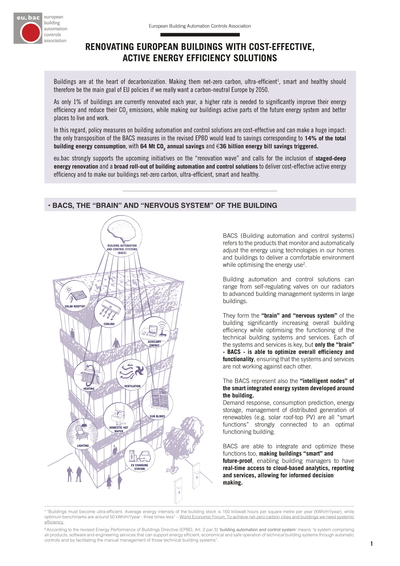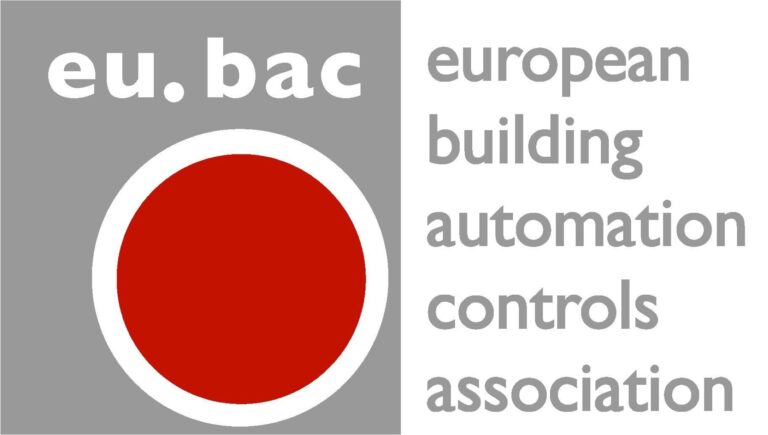eu.bac 3-pager “Renovating European buildings with cost-effective, active energy efficiency solutions”

- READ THE 3-PAGER IN PDF HERE (suggested)
Buildings are at the heart of decarbonization. Making them net-zero carbon, ultra-efficient[1], smart and healthy should therefore be the main goal of EU policies if we really want a carbon-neutral Europe by 2050.
As only 1% of buildings are currently renovated each year, a higher rate is needed to significantly improve their energy efficiency and reduce their CO2 emissions, while making our buildings active parts of the future energy system and better places to live and work.
In this regard, policy measures on building automation and control solutions are cost-effective and can make a huge impact: the only transposition of the BACS measures in the revised EPBD would lead to savings corresponding to 14% of the total building energy consumption, with 64 Mt CO2 annual savings and €36 billion energy bill savings triggered.
eu.bac strongly supports the upcoming initiatives on the “renovation wave” and calls for the inclusion of staged-deep energy renovation and a broad roll-out of building automation and control solutions to deliver cost-effective active energy efficiency and to make our buildings net-zero carbon, ultra-efficient, smart and healthy.
- BACS, the “brain” and “nervous system” of the building
BACS (Building automation and control systems) refers to the products that monitor and automatically adjust the energy using technologies in our homes and buildings to deliver a comfortable environment while optimising the energy use[2].
Building automation and control solutions can range from self-regulating valves on our radiators to advanced building management systems in large buildings.
They form the “brain” and “nervous system” of the building, significantly increasing overall building efficiency while optimising the functioning of the technical building systems and services. Each of the systems and services is key, but only the “brain” – BACS – is able to optimize overall efficiency and functionality, ensuring that the systems and services are not working against each other.
The BACS also represent the “intelligent nodes” of the smart integrated energy system developed around the building. Demand response, consumption prediction, energy storage, management of distributed generation of renewables (e.g. solar roof-top PV) are all “smart functions” strongly connected to an optimal functioning building. BACS can integrate and optimize these functions too, making buildings “smart” and future-proof, enabling building managers to have real-time access to cloud-based analytics, reporting and services, allowing for informed decision making
- The 3 pillars of an energy efficient building
The energy efficiency of buildings is based on three pillars, of which “Active control of energy usage”, provided through building automation and control solutions, is an essential one. While often overlooked, this is a key complementary pillar to ensure that measures on the envelope and energy generation deliver in practice what they promise in theory.
The active control of energy usage ensures an optimal distribution and consumption of energy in the building and leads to a more efficient use of the generated energy.
In addition, the reduced energy demand due to improved insulation assumes that the indoor environmental comfort remains constant before and after the measure is applied, and active controls are needed to ensure this is the case.
With the increased share of renewables in the energy system and the integration of distributed energy resources at end-use level, the roll-out of solutions such as building automation and controls will be critical to manage energy usage.
- Indoor Environmental Quality: a key element for health, well-being and productivity
The World Health Organisation estimates that we spend approximately 90% of our time indoors, in residential and non-residential buildings.
The level of CO2, humidity and other pollutants have a considerable impact on the health, well-being and productivity of the occupants.
BACS optimize thermal comfort, air quality, lighting levels and operational efficiency while preventing legionella and other infections.
BACS are therefore essential in order to create healthy, productive, safe and comfortable spaces for people. Harvard Research[3], with tests conducted on participants in a closed environment, showed an 8% increase in productivity for those who benefitted from better Indoor Environmental Quality over participants who didn’t benefit from the improved conditions. This was then quantified as a $6,500 increase in productivity per employee per year.
- Staged-deep renovation, the cost-effective driver to decarbonisation
The ultimate goal of the “Renovation Wave” is to speed up the process towards net zero carbon buildings: all types of renovation that contribute to the achievement of this objective should be supported and accelerated.
Several studies point to the numerous advantages of staged-deep renovation[4]: due to the lower upfront cost, staged-deep renovation enables more people to engage in energy renovations and can thus helps achieve a considerable amount of energy savings in a short time. Moreover, staged-deep renovation allows for less disruptive and more cost-efficient renovation measures by aligning them with given ‘trigger-points’. This approach is therefore sustainable and flexible, as it links different measures to different “events”, whether practical opportunities (e.g. need for repairs or building an extension), personal “events” (e.g. a new-born in the family, retiring or children moving out), or change of ownership.
More importantly, staged-deep renovations have proven to be cost-effective, as they need lower investment at a time and, especially, prioritize the interventions on the buildings with faster returns from investments. For example, installation of BACS is an essential part of any renovation with limited upfront costs (30€/m2 in non-residential buildings and 12€/m2 in residential buildings[5]) and with the value of energy savings exceeding the value of investments by a factor of 9[6]. Setting these interventions first would therefore activate further investments in the renovation of the building, thanks to the savings accumulated with this first step.
- What policy measures are needed?
Ensure full implementation and enforcement of BACS measures in the revised EPBD
The revised EPBD includes measures requiring the deployment of building automation and control advanced functionalities in all large non-residential buildings (existing and new, with effective rated output > 290kW) and the installation of self-regulating devices (such as Thermostatic Radiator Valves) for the individual regulation of the temperature in each room (in both residential and non-residential buildings, existing – when heat generators are replaced – and new).
An ambitious transposition of the BACS measures included in the revised EPBD could lead to savings corresponding to 14% of the total building energy consumption, with 64 Mt CO2 annual savings and €36 billion energy bill savings triggered[7].Despite these figures, the Member States showed a lack of ambition when transposing these measures at national level, jeopardising the achievement of these savings. It is essential to ensure full implementation and enforcement of these BACS measures, as they have the potential to significantly contribute to the achievement of the EU climate goals.
Enlarge the scope of buildings equipped with BACS functionalities
In order to achieve the higher EU climate goals as set by the European Green Deal, more policy measures need to be put in place. The mandatory requirements for BACS functionalities set in the revised EPBD cover only a very small part of the building stock (only large non-residential buildings). The European Commission should therefore extend the existing requirements, to include medium-size non-residential buildings and larger residential buildings
A first step in this direction should be set by the Renovation Wave, ensuring that these additional categories of buildings are equipped with BACS functionalities, at least when they undergo renovation. This would result in a dramatic improvement of the energy consumption of the buildings[8], taking them towards net-zero carbon and making them ultra-efficient, smart and healthy.
Create a dedicated Renovation Fund for the deployment of smart technologies
After the COVID-19 crisis, new economic and financial measures are needed in order to boost the economy, while accelerating the transition to green, smart buildings. The technologies are available, but the lack of investments can seriously hinder the transition. The Roadmap to the Renovation Wave[9] points out that “achieving a decarbonised building stock by 2050 will require the effective mobilisation of public and private finance”. For these reasons, eu.bac calls on the European institutions to create a dedicated Renovation Fund for the deployment of smart technologies, open to all the economic actors and easy to access.
Increase the rate of staged-deep renovation
A faster rate of renovation is necessary to achieve the EU climate goals. In this framework, eu.bac believes that the increase of the renovation rate at EU level should be achieved by prioritizing staged-deep renovations, due to their cost-effectiveness, sustainability and flexibility. In order to do this, it is important to facilitate access to finance, and to also put in place minimum standards and mandatory requirements. The advantages of a focus on staged-deep renovation would be greater certainty of achieving better energy performance, in a shorter timescale and with a sustainable level of expenditure that prioritises the interventions on cost-effective technologies.
[1] “Buildings must become ultra-efficient. Average energy intensity of the building stock is 150 kilowatt hours per square metre per year (kWh/m2/year), while optimum benchmarks are around 50 kWh/m2/year — three times less” – World Economic Forum, To achieve net-zero carbon cities and buildings we need systemic efficiency
[2] According to the revised Energy Performance of Buildings Directive (EPBD, Art. 2 par.3) ‘building automation and control system’ means a system comprising all products, software and engineering services that can support energy efficient, economical and safe operation of technical building systems through automatic controls and by facilitating the manual management of those technical building systems
[3] Harvard Business Review, Research: Stale Office Air Is Making You Less Productive
[4] Planned staged deep renovations as the main driver for a decarbonised European building stock, BPIE-ifeu, Integrated Renovation Process: Overcoming Barriers to Sustainable Renovation, Aalborg University
[5] The scope for energy and CO2 savings in the EU through the use of building automation technology, Waide Strategic Efficiency Limited
[6] “The impact of the revision of the EPBD on energy savings from the use of building automation and controls”, Waide Strategic Efficiency Limited
[7] “The impact of the revision of the EPBD on energy savings from the use of building automation and controls”, Waide Strategic Efficiency, 2019
[8] According to EN15232-Impact of BACS and TBM on energy performance of buildings, BACS reduce thermal and electrical energy consumption to 26% in educational institutions and hospitals, 27% in residential buildings, 41% in hotels and estaurants, 49% in wholesale and retail buildings, 52% in offices and lecture halls
[9] Roadmap “Renovation Wave” initiative for the building sector
